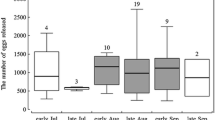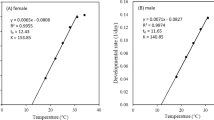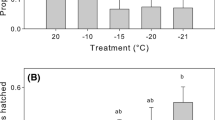Abstract
This study shows that water stress is not countered in eggs of the lone star tick, Amblyomma americanum (L.), using water vapor, and suggests involvement of liquid water as a developmental cue. Eggs fail to maintain an equilibrium water content in subsaturated air, hence, gain ≠ loss, with net water losses occurring at relative humidities near saturation and these eggs exhibit a three-fold drop in viability, but not incubation period, as compared to eggs held in saturated air. Amblyomma americanum eggs are stenohydric and feature low 58% water content, slow water losses <1%/h, and an impermeable chorion wherein the Arrhenius activation energy, E a = −66 J/K, is suppressed. Thus, enhancement of water retention, not water vapor absorption, permits eggs to resist desiccation.
Similar content being viewed by others
References
Arlian L.G. and Ekstrand I.A. 1975. Water balance in Drosophila pseudoobscura, and its ecological implications. Ann. Ent. Soc. Am. 68: 827–832.
Gibbs A.G. 1998. The role of lipid physical properties in lipid barriers. Am. Zool. 38: 268–279.
Hadley N.F. 1994. Water Relations of Terrestrial Arthropods. Academic Press, New York, USA.
Heath A.C.G. 1979. The temperature and humidity preferences of Haemaphysalis longicornis, Ixodes holocyclus and Rhipicephalus sanguineus (Ixodidae): studies on eggs. Int. J. Parasitol. 9: 33–39.
Hinton H.E. 1981. Biology of Insect Eggs. Pergamon Press, New York, USA.
Johnson C.G. 1940. The maintenance of high atmospheric humidities for entomological work with glycerol-water mixtures. Ann. Appl. Biol. 27: 295–299.
Lancaster J.L. and McMillan H.L. 1955. The effects of relative humidity on the lone star tick. J. Econ. Entomol. 48: 338–339.
Lees A.D. and Beament J.W. 1948. An egg-waxing organ in ticks. Quart. J. Micr. Sci. 89: 291–332.
Londt J.G.H. 1975. A rapid spectrophotometric method for the monitoring of embryonic development in ticks. Quart. J. Micr. Sci. 89: 291–332.
Needham G.R. and Teel P.D. 1991. Off-host physiological ecology of ixodid ticks. Ann. Rev. Entomol. 36: 659–681.
Rechav Y. and von Maltzahn H.C. 1977. Hatching and weight changes in eggs of two species of ticks in relation to saturation deficit. Ann. Entomol. Soc. Am. 70: 768–770.
Sigal M.D. 1990. The water balance physiology of the lone star tick, Amblyomma americanum (Acari: Ixodoidea), with ecophysiological comparisons to other ixodid species. Ph.D. Dissertation, The Ohio State University, Columbus, USA.
Sokal R.R. and Rohlf F.J. 1981. Biometry. W.H. Freeman, New York, USA.
Sonenshine D.E. 1991. Biology of Ticks. Oxford University Press, New York, USA.
Sonenshine D.E. and Tigner J.A. 1969. Oviposition and hatching in two species of ticks in relation to moisture deficit. Ann. Entomol. Soc. Am. 62: 628–640.
Teel P.D. 1984. Effect of saturation deficit on eggs of Boophilus annulatus and B. microplus (Acari: Ixodidae). Ann. Entomol. Soc. Am. 77: 65–68.
Theiler G. 1964. Ecological aspects of tick distribution, Vol. 21. In: Davis D.H.S. (ed) Ecological Studies in Southern Africa. Monogr. Biol. 14: 284–300.
Toolson E.C. 1978. Diffusion of water through the arthropod cuticle: thermodynamic consideration of the transition phenomenon. J. Thermal Biol. 3: 69–73.
Wharton G.W. 1985. Water balance of insects. In: Kerkut G.A. and Gilbert L.I. (eds) Comprehensive Insect Physiology, Biochemistry and Pharmacology. Vol. 4. Pergamon Press, Oxford, pp. 565–603.
Winston P.W. and Bates D.S. 1960. Saturated solutions for the control of humidity in biological research. Ecology 41: 232–237.
Yoder J.A. and Benoit J.B. 2003. Water vapor absorption by nymphal lone star ticks, Amblyomma americanum, and its ecological significance. Int. J. Acarol. 29: 259–264
Yoder J.A. and Denlinger D.L. 1991. Water balance in flesh fly pupae and water vapor absorption associated with diapause. J. Exp. Biol. 157: 273–286.
Yoder J.A. and Denlinger D.L. 1992. Water vapour uptake by diapausing eggs of a tropical walking stick. Phys. Entomol. 17: 97–103.
Yoder J.A. and Houck M.A. 2001. Xeric survival without drinking by hypopodes of Hemisarcoptes cooremani (Acari: Hemisarcoptidae). Int. J. Acarol. 27: 59–62.
Author information
Authors and Affiliations
Corresponding author
Rights and permissions
About this article
Cite this article
Yoder, J.A., Benoit, J.B. & Opaluch, A.M. Water relations in eggs of the lone star tick, Amblyomma americanum, with experimental work on the capacity for water vapor absorption. Exp Appl Acarol 33, 235–242 (2004). https://doi.org/10.1023/B:APPA.0000032955.59421.78
Issue Date:
DOI: https://doi.org/10.1023/B:APPA.0000032955.59421.78




